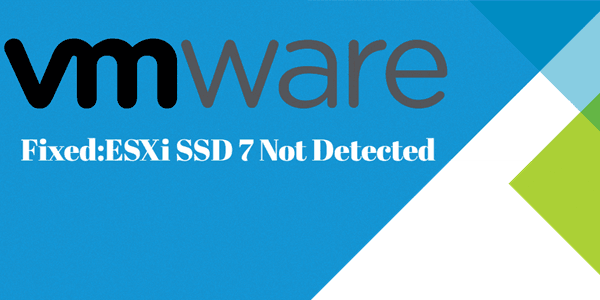SSDs are critical to the performance and reliability of virtualized environments. However, if ESXi does not detect SSDs, the efficiency of the environment can be severely impacted.

VMware ESXi 7 relies heavily on the underlying hardware, including storage devices such as SSDs, which are critical for data storage, hosting and running virtual machines.
However, there are some challenges when running VMware ESXi 7.
🔰 SSD Compatibility issues:
Not all SSDs are compatible with ESXi 7. For some users who upgraded to ESXi 7, ESXi NVMe was not detected. Your NVMe SSD is not officially listed on VMware's Hardware Compatibility List (HCL), so the hypervisor may not recognize it.
🔰 Hardware configuration issues:
In some cases, the problem may simply be a loose connection or incorrect placement of the SSD in the slot. In addition, the configuration of the storage controller or SSD mode (such as AHCI or RAID) in the BIOS/UEFI can affect detection.
🔰 ESXi 7 Software error or failure:
Sometimes a software error or incomplete ESXi 7 installation can cause the system to fail to recognize an attached SSD. These issues can usually be resolved with a software update or patch provided by VMware.
Next, we will introduce how to fix the issue of ESXi 7 SSD not showing up.

By following these steps, you should be able to diagnose and fix the issue of an SSD not being detected in VMware ESXi 7. Ensure that your hardware is compatible, connections are secure, and drivers are up to date.
1. In vSphere Client, go to Host > Actions > Services > Enable Secure Shell (SSH).
2. Once you have access to the ESXi CLI, you can identify the SSD by running the following command:
This command will list all the storage devices attached to the ESXi host. Look for your SSD in the output. If the SSD is not listed, there may be a connection or compatibility issue.
3. If the SSD is not detected, you can try rescanning the storage adapters. Enter this command to detect the SSD in ESXi.
4. After rescanning, check if the SSD is now detected by running:
If the SSD is detected, it should appear in the list.
5. To further investigate the SSD's status, you can check detailed information using:
Replace with the identifier of your SSD, which you can find from the previous commands.
6. If the SSD is still not detected, check the ESXi logs for any related errors:
7. Ensure that the storage controller drivers are up to date. You can check the version of the drivers currently in use by running:
Using ESXi CLI commands can greatly assist in troubleshooting and resolving such issues.
To enhance the reliability and security of your VMware ESXi 7 environment, especially when dealing with issues like SSDs not being detected, it's crucial to have a robust backup solution in place.
💥Imagine this: you’ve just spent hours troubleshooting your SSD issue using the steps above, but what if, during the process, something goes awry? You might lose critical data or configurations that could set you back even further. With AOMEI Cyber Backup, you have the peace of mind that your VMware ESXi 7 virtual machines are backed up regularly and securely.
AOMEI Cyber Backup is designed for managing VMware ESXi backups. Here’s what it brings to you:
1. Bind Devices: Access to AOMEI Cyber Backup web client, navigate to Source Device > VMware > + Add VMware Device to Add vCenter or Standalone ESXi host. And then click … > Bind Device.
2. Create Backup Task: Navigate to Backup Task > + Create New Task, and select VMware ESXi Backup as the Backup Type.
3. Set Task Name, Device, Target, Schedule, and Cleanup as needed.
4. Restore: You can create a new VM by hitting Restore button, and it allows you to restore VM to original/new location directly from any selected backups, which saves the trouble of re-configuring the new VM.
In conclusion, addressing the issue of an SSD not being detected in VMware ESXi 7 requires a methodical approach using ESXi CLI commands, ensuring that hardware is compatible, connections are secure, and drivers are up to date.
However, even the best troubleshooting efforts can’t eliminate the risk of unexpected data loss or downtime. That’s why using AOMEI Cyber Backup with your VMware ESXi environment is essential. It provides automated, reliable backups and quick recovery options, ensuring that your virtual machines remain protected and your business operations continue without interruption.
By combining these troubleshooting techniques with a robust backup solution, you’re well-equipped to handle any challenges that arise.